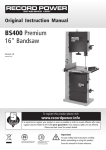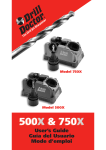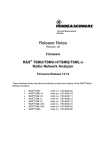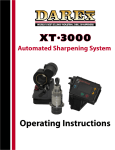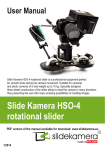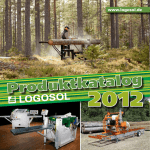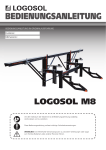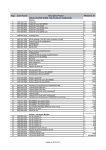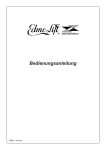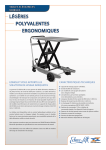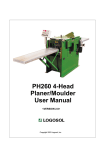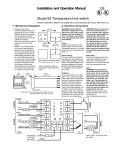Download Logosol BS350
Transcript
BS 350 User's Manual LOGOSOL BS350 Read this manual before starting to use this equipment. This manual contains safety instructions. Warning! Failure to follow the instructions can cause serious injury. English BS 350 2 3 4 4 4 4 4 5 5 5 6 6 7 8 9 10 11 11 Introduction Safety Instructions Machine Description Using bandsaws Installation Starting the Bandsaw The Carriage Before each Work Shift After each Work Shift Changing Saw Blade Maintenance of the Saw Blade Adjusting the Blade Guides Cooling the Saw Blade Sawing with the BS320 Make Sure That... Circuit Diagram Technical Data EU Declaration of Conformity Thank you for choosing a machine from LOGOSOL. LOGOSOL began production of the Logosol Sawmill in 1989. Since then we have developed a product programme for small-scale wood processing. We have a wide range of machines and accessories that enable you to be in charge throughout the entire process, from tree felling to finished wood products. For the Logosol Sawmill there are several accessories available, e.g. chainsaws, extensions, supplement for oversized logs, log house moulder, safety equipment, aids for log handling, etc. Call LOGOSOL, and we will send you information about our entire wood processing programme. If you are interested in a specific product, we have video films which show the machines in action. You have now bought the BS350, an efficient bandsaw adapted for the Logosol Sawmill. If you have any questions about your BS350, do not hesitate about contacting us at LOGOSOL. Our aim is to make you yet another satisfied owner of one of our products. We wish you all the best with your new machine! Bengt-Olov Byström MD and founder of Logosol LOGOSOL is constantly developing its products. For that reason we reserve the right to make changes in the design and construction of our products. Text and illustrations: Mattias Byström, 2004-06-01. Translation: Anna Olsgren Byström Revised 2009-01-07 Copyright 2004 LOGOSOL, Härnösand, Sweden 2 BS 350 Safety Instructions Make sure that the equipment is in good condition, and that all screws are firmly tightened. When using the Bandsaw the Logosol Sawmill must stand on plane and level ground. The Logosol Sawmill should be equipped with feet (ref. no. 4510-723-1500) and support legs (ref. no. 4510720-6800) which are fastened to the ground with sturdy screws or bolts. The Bandsaw may not be connected until you have made sure that it is properly mounted on the guide rail, and that the bandsaw carriage clasps both the guide rail flanges so that it cannot be lifted from the guide rail. Also make sure that the plastic safety cover is correctly mounted and locked. Before starting the bandsaw, always check that: ...the Logosol Sawmill is securely fastened to the ground. ... the BS350 is properly mounted on the sawmill's guide rail. ...no tools are inside the plastic safety cover. ...you are standing firmly. ...the log is lying firmly on the log beds of the sawmill. ...no assistants or onlookers are within the safety distance of the Logosol Sawmill. Always pull out the plug before: ...opening the plastic safety cover. ...tensioning the saw blade. ...cleaning or other maintenance is performed. ...removing the saw from the sawmill. Be aware that the bandsaw is a dangerous tool that should always be handled with respect. Always switch off the bandsaw when you are not sawing. The saw should always be switched off when you are lifting logs on or off the sawmill. Always stand behind the control arm, and never reach over the sawmill guide rail while the machine is running. Do never reverse the saw while it is running. Wait until the saw blade has stopped, otherwise the saw blade can be hurled out from the wheels. Never leave the bandsaw unattended when it is plugged in. The machine may only be started by a person who has read and understood all of the instructions in this manual. The manual should always be accessible to those who use the sawill. The manual should go with the sawmill when it is lent or sold to someone else. Read the manual and safety instructions for the saw unit that is used on the Logosol Sawmill. Do not place the electric cable where you can tread or trip on it. The electric cable should be suspended by a wire choker rope above the sawmill (Wire Kit 10 m ref. nr: 6605-000-0300) The machine may not be altered or modified. Only use original parts from LOGOSOL. LOGOSOL disclaims all responsibility for personal injury or damage on property caused by a sawmill equipped with non-approved parts, or modified in any other way. After service and maintenance, the machine must be restored to its original condition. Clean the bandsaw every time you have used it. Always keep your work site clean from things you can trip on. The Bandsaw may only be used in good visibility conditions. How to lift the Bandsaw. The Logosol Sawmill should be equipped with a loading ramp (ref. no. 7000-000-0000). It takes two persons to lift the bandsaw onto the guide rail. For your own safety, do not use the equipment before having read and understood the entire manual. Do not let other persons who have not read the instructions use the equipment. Also read the manual for the Logosol Sawmill and the chainsaw you are using. Use approved hearing protectors and eye protectors. Hearing can be impaired after only a short exposure to the highfrequency sounds of the saw. Use protective gloves when operating BS350. It is especially important to have stout protective gloves when handling the saw blades. Use protective shoes or boots with deeply patterned soles. Shoes with steel toes are recommended. Never start the saw when the plastic safety cover is removed. If the saw blade is hurled out from the wheels it can cause personal injury. 3 BS 350 Machine Description BS350 is constructed for mounting on the Logosol sawmill. The frame is made from cast aluminium in order to minimize the weight. Aluminium also has the unique ability to reduce vibrations. The wheels, on which the saw blade runs, are also made of cast aluminium and equipped with bearinged hubs of steel. The saw blade is guided by adjustable glide blocks in graphite. The bandsaw comes with a 35 x 1.1 mm (1 7/16'' x 1/16") tooth tip tempered saw blade with a tooth pitch of 3/4”. The saw blade is directly run by a three-phase motor with 5 kW continuous output. The saw blade must be lubricated and cooled by, for example, water. Whe the saw is turned off, the water flow is stopped by a solenoid valve. The saw blade is tensioned with the help of a spring loaded threaded bar which is placed between the centres of the wheels to minimize tensions in the construction. The bandsaw carriage is equipped with ball bearings. The saw bench is stabilized with extra mid-struts which comes with the package. Using Bandsaws The saw blade on the bandsaw is approx. 1 mm (ca. 1/16") thick. This entails both advantages and disadvantages. One advantage is that the sawblade kerf is narrow, which enables you to saw very fast. There will be little sawdust, and the sharpness of the saw blade will last comparatively longer. One disadvantage is that the thin saw blade is more sensitive to variations in the wood, such as knots. You can, however, minimize those deviations by decreasing the feeding speed when suspecting big knots in the wood. Sawing with a bandsaw is not as easy as it looks. It takes a certain amount of carefulness, practice, and experience to obtain a perfect result. Installation The Logosol Sawmill must be fixed to the ground according to its manual. In addition, support legs are to be fitted to each end of the guide rail. These support legs are also to be firmly fixed to the ground. Two extra guide rail struts are fitted to the centre of the sawmill guide rail. The loading ramp is fitted in the end of the guide rail, i.e. the end where you will push the bandsaw onto the sawmill. Suspend the electric cable by a wire above the sawmill so that you do not risk treading or tripping on it. Use Logosol's wire kit 6605-000-0300. Starting the Bandsaw The bandsaw is equipped with a safety control. To start the machine: Make sure that there is no one within the safety distance of the Logosol Sawmill and that the bandsaw is ready for start according to the safety instructions. 1. Connect the electric cable. 2. Turn on the main power switch. 3. Press down the yellow button 4. Squeeze the black handle and the motor will start. When you release the handle the motor stops. The bandsaw's start control with "dead man's handle". The Carriage The sliding function of the carriage is accomplished by two slide profiles which ensure an exact position of the carriage on the guide rail. The pressure on these slide profiles is reduced by four ball bearings, in order to make it easy to push the saw by hand. 4 BS 350 Before each Work Shift - Tension the saw blade until you can see the red mark (see "Changing Saw Blade"). The knowledge of the proper tension of the saw blade is one of the things you gradually learn when using a bandsaw. One basic rule is that the saw blade should be as little tensioned as possible. The bandsaw should stop within 10 seconds after the black handle is released. If it takes longer time for the saw blade to stop, it should be more tensioned. - Make sure that the saw blade rotates in the correct direction. If it rotates the wrong way, you can change the direction by rotating the phase reverser (a white plastic disc in the connecting plug, which can be rotated with a flat screwdriver). - Make sure the equipment is in good condition. Also check the electric cable and the Logosol Sawmill. - Make sure that the saw is properly mounted on the guide rail. After each Work Shift - Pull out the plug. - Loosen the blade tension (see "Changing Saw Blade") so that the saw blade is slack. - Clean and check the equipment. - Cover the saw with a tarpaulin if it is stored outdoors. - Empty the water out of the water system if there is risk of temperatures below 0°C. - Electric motors are to be stored in a heated room to prevent condensation in the motor housing, something that can occur when there are fluctuations of temperature. If the motor is stored in a cold room, you should check that there is no water in the motor before connecting it to electricity. Sealed electric motors have a tap on the underside that you loosen to check if there is water in the motor. Changing Saw Blade Use protective gloves. - Stop the saw and pull out the plug. - Open the plastic safety cover. - Loosen the blade tension with a 19 mm spanner, according to the picture in the upper right corner. - Lift off the old blade. The saw blade is tensioned with a 19 mm spanner. Clean the saw from sawdust, and make sure that: - the blade guides are not worn. - all screws are firmly tightened. Make sure that the teeth on the new saw blade point in the correct direction. If this is not the case, turn the saw blade inside out. Handle the saw blade carfully when unpacking it and do not bend it with force. There is risk of being injured by the sharp teeth, and the saw blade can get ridges which cannot be straightened out. - Fit the new saw blade. - Tension the saw blade until the red mark is visible. The saw blade should stop within 10 seconds. Rotate the wheels manually a couple of turns, and make sure the saw blade is completely centred on the wheels. The teeth should not be in contact with the wheels. If the teeth do not run freely the tooth set will be damaged. If the saw blade is not properly centred you can adjust its position: Open the lock nut on the outer axle, and adjust the tilt screw in order to reposition the saw blade. If you turn the screw anticlockwise the saw blade will move outwards, if you turn it clockwise the saw blade moves inwards. Rotate the wheels manually a couple of turns to see the effect of the adjustment. Tighten the lock nut. Close the plastic safety cover. Check that the machine stops within 10 seconds. Take a couple of cuts and then check once more that the blade is completely centred. 5 BS 350 Maintenance of Saw Blades Sawing is almost always trouble-free with a new saw blade. After some time of sawing with the blade the results will begin to degrade, though. When this happens, you have to change saw blade immediately. A saw blade that does not work cannot be made to saw straight by the help of the blade guides or increased blade tension. Sometimes, however, you can increase the serviceable time somewhat by tensioning the saw blade a bit more. The number of cuts you can make before changing the saw blade can vary considerably. This is mostly due to how much dirt there is in the bark of the logs. Normally you can cut 15-25 logs, or 25-50 cuts through bark. The majority of saw blades for small timber bandsaws are tooth tip tempered, and are often considered as disposables which are to be thrown away when the sharpness is lost. You can, however, sharpen the blades. Machines for sharpening bandsaw blades can be more or less advanced. The simplest type of machines only sharpens the front of the tooth and the gullet. Since the blades can only be sharpened a couple of times, it is not necessary to sharpen the tooth back. Sharpening the front of the teeth brings the sharpness back; sharpening the gullets prevents cracks in the blade. the blade is about to break. Immediately interrupt sawing if you hear that the blade is starting to break. A saw blade that breaks can damage the equipment. If the saw blade is sharpened several times, it can be necessary to adjust the tooth set. There are machines for this too, but in practise the only realistic alternative is to do it manually with the help of a pair of special pliers for adjusting the tooth set. Adjusting the Blade Guides The blade guides should touch the blade with a fairly light pressure. With the help of the blade guides the saw blade can be adjusted so that it is parallel with the log bed. Both blade guides are fastened with a M8 screw. After a couple of sharpenings the saw blade is worn out, and cracks appear in the gullets. The cracks grow quickly, and the blade breaks if you do not stop sawing. Clear clicking sounds is an indication that A built-in chip extractor! As you can see in the picture under "Adjusting the Blade Guides" there is a barrier in front of the driving wheel that creates a fan housing. The air intake at the centre of the wheel further improves the air flow. Sawdust always accumulates in bandsaws, but the design of the machine significantly reduces this problem! 6 BS 350 Cooling the Saw Blade You can cool the bandsaw blade with water, but there are also additives which you can mix in the water to improve the lubrication. Fill the two connected bottles with water. Together, the both bottles hold 2 litres. This is normally enough for 2-4 logs. When sawing fresh timber, the water flow should be approx. 4 drops per second. Increase the flow when sawing dry timber. The water supply is controlled by a solenoid valve which opens when the motor starts running and closes when the motor stops. The flow is adjusted with the handle on the tube. Bottles for water Solenoid valve Copper pipe TIP: Keep a water container nearby the sawmill so that you can easily refill the water bottle. Balancing valve Avoid getting sawdust in the water bottles. If the water supply stops: 1. Loosen the tube from the copper pipe down by the saw blade and blow the copper pipe clean using compressed air. If this does not help: Copper pipe 2. Remove the saw blade and remount the plastic safety cover. 3. Empty the bottles and let them stay open. 4. Open the water-flow balancing valve completely. 5. Loosen the tube from the copper pipe down by the saw blade. 6. Start the motor so that the solenoid valve opens, and blow compressed air through the back way of the tube. If water is still not supplied, it can be due to a defective solenoid valve. Contact Logosol. To prevent the solenoid valve and the balancing valve from freezing, empty the water system if there is risk of the bandsaw getting exposed to temperatures below 0°C. Add glycol to the water when using the saw in temperatures below 0°C. 7 BS 350 Sawing with the BS350 You can saw logs up to about 40 cm (16'') in diameter on Logosol's bandsaw, and the cant width can be 32 cm (13'') as a maximum. For larger diameters the bandsaw must be supplemented with a chainsaw. Usually one cut with the chainsaw is enough to make the log fit for bandsawing. If the chainsaw is to be used mainly for sawing occational cuts to decrease the dimension of logs so that the logs can be sawn with the bandsaw, a powerful petrol-powered chainsaw is in most cases a suitable alternative. If you want higher capacity and a more silent-running chainsaw Logosol has electric chainsaw units, e.g. Logosol E5000. There are, however, another reason for using a chainsaw than the fact that the logs sometimes are too large for the BS350. A bandsaw blade is very sensitive to dirt on the logs, while a saw chain is considerably more durable and, in addition, easily sharpened several times. Due to this, BS350 is often used only for cutting the boards, while the first cuts are taken with a chainsaw. The sharpness of the blade will last for a large number of cants, the sawing yield will significantly increase, and you can saw the cants quickly. By combining a chainsaw with a bandsaw you will have a very efficient small-scale sawmill with a great degree of flexibility, a high sawing yield, and a capacity that is close to the capacity of more expensive machines. If a considerable part of the work is to be made with the help of a chainsaw, an electric sawing unit is, of course, preferable. If you want your bandsaw blades to have longer serviceable time, barking the timber is an alternative to making cants with a chainsaw. If you want to saw as much as possible using the bandsaw, i.d. also cut the cants with it, it is important that you make sure the diameter of the timber is within the limit of what the bandsaw can take. A cut is quickly and easily made with the bandsaw. Make sure the saw blade cuts perfectly. If the blade changes direction when sawing through big knots, it can be a sign that the blade needs to be tensioned, or that the feeding speed is to high, but it can also be the first sign of the blade starting to lose its sharpness, which means that it has to be replaced. If you do not change the blade in time, you will inevitably end up with imperfectly sawn timber. Thus, it is important that you make sure the blade is sawing straight. As long as the blade follows the 8 sawn surface on the log when pulling the saw back, the blade is cutting the way it is supposed to. The Logosol Sawmill is designed to be used together with a chainsaw that has a kerf width of approx. ¼ inch, or just over 6 mm. When cutting a log into boards with a chainsaw, you get boards with dimensions that correspond to even quarter-inch steps. With a bandsaw blade, whith a kerf of only 2 mm (1/8"), you get dimensions that are approx. 2 mm under, or approx. 4 mm (3/16") over even quarter-inch steps. With the Logosol M7 Sawmill you have the possibility to use half quarter-inch steps, which means that the boards will either be approx. 1 mm (1/16") thinner or 1 mm thicker than when sawing with a chainsaw. Another aspect is that the stability of the Logosol Sawmill is adapted for using a chainsaw. A chainsaw has only a small part of its weight outside the guide rail, while the bandsaw has an overhang, which makes the centre of gravity lie just outside the guide rail edge. In addition, the bandsaw is heavier than a chainsaw. The stability of the Logosol Sawmill is increased by using the extra mid-strut, which comes with the BS350 package, and sturdy support legs that secure the guide rail ends, but the cutting unit is still fairly unstable. This means that the cutting unit will move when you start the motor, but once the cutting process has started, the saw will move in a straight line, and the limited stability will not affect the sawing precision at all. BS 350 Make sure that: 1. you read and follow all safety instructions. 2. the blade tension is loosened when the bandsaw in not in use. 3. you use protective gloves when handling bandsaw blades. 4. you cover the electric equipment when the bandsaw is stored outdoors. 5. you bark dirty logs, or make them into cants with a chainsaw. 6. you change saw blade when it does not cut straight. 7. you stop the saw immediately when you hear clicking sounds indicating that the blade is about to break. 8. you never reverse the saw while the saw blade is running. 9. you call Logosol if you have any problems, or just to tell us that the saw works well. If some form of operational disturbance occurs, immediately stop sawing and turn the machine off before solving the problem. Be aware that accidents with dangerous machines, no matter if it is a Logosol Sawmill or another machine, happen most frequently when the operator e.g. is removing sawdust or is trying to correct a small problem while the machine is running. An operational stop can seldom be seen on the finished product. 9 BS 350 Lethal voltage! Risk of electric shock. Do not open the the electrical system if you are not a qualified electrician. Electrical installations may only be carried out by a qualified electrician. The circuit diagrams that are placed inside the electric box of the bandsaw are the ones that are relevant. Circuit diagram for 3x400V Connection between the junction box on the motor and the solenoid valve. Yellow-green earth Junction box Brown Blue Solenoid valve 1 2 3 Earth 4 6 Circuit diagram for 3x230V 10 BS 350 Technical Data Effect Continuous Output: 5 kW Peak Power: approx. 10 kW Electrical System Electricity Supply: 50 Hz 400 V 16 A, or 50 Hz 3x230V depending on the model. Enclosure protection class: IP 54 Plug, 400V: CEE system (round plug) 16A, with phase reverser Contactor operated, with auxiliary relay. Thermo guards in the motor coils Blade Speed: approx. 30 m/s. Recommended by the blade manufacturer. Blade Type: Length: Lubrication/Cooling: Blade tension: Blade Guides: Tooth tempered 35 x 1,1 mm (1 7/16'' x 1/16'') with a tooth pitch of 3/4” (other types can be used). approx. 2900 mm (114'') Adjustable drip lubrication with solenoid valve Linear. Spring loaded threaded bar. Adjustable graphite blocks Construction Chassis: Wheels: Carriage: High strength cast aluminium Cast aluminium wheels with steel coating in the centre. Diameter 390 mm (15''). Slide profiles of low-friction plastic with adjustable ball bearings. Sound Levels Sound Pessure Level: In operation100 dB(A) LwA 109 dB(A) LwA : Dimensions Height: Length: Width: Weight: 0,5 m (19 3/4'') 1,25 m (49 5/16'') 0,5 m (19 3/4'') approx. 50 kg (110 lbs) Accessories 25 m (82 ft) electric cablel 2,5 mm2 Plug CPE 416-6 Socket Coupler CSE 416-6 Loading Ramp Support legs Wire kit 10 m (33 ft) Ref. no. 9999-000-6801 9999-000-6090 9999-000-6091 9999-000-0920 6600-000-3001 6605-000-0300 Declaration of Conformity The manufacturer, Logosol AB, Industrigatan 13, S-871 53 Härnösand, tel. +46 611 18285, hereby declares that BS 350, ref. no. 9999-000-7500, is manufactured in accordance with: Machinery Directive 98/37/EG, EMC-directive 2004/108/EG and LVD-directive 2006/95/ EG, Härnösand 2008-02-27 Bengt-Olov Byström, MD and that it is manufactured in accordance with the following harmonized standards: EN ISO 12100-1, -2:2003, EN 1807:1999, EN 60204-1:2006, EN 61000-6-1, -3. The equipment may only be used together with the Logosol Sawmill. Certifying body: SMP Swedish Machinery Testing Institute AB 0404, Uppsala, Sweden has issued: Type approval certificate: 484/95/1/E2 Machines with ref. no. 9999-000-7500 correspond with the one examined by SMP. 11 BS 350 www.logosol.com www.logosol.co.uk Industrigatan 13 - 871 53 Härnösand - Sweden - Phone +46 611-18285 - Fax +46 611-18289 - [email protected] 12




















